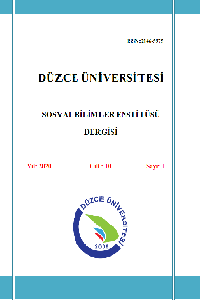SATRANÇ OYNAMA MOTİVASYONUNUN SATRANÇ OYUN GÜCÜNE ETKİSİ: ÖZEL YETENEKLİLER ÜZERİNDE BİR İNCELEME
Satranç motivasyonu, satranç oyun gücü, profesyonel satranç oyuncusu
___
- Açış, Y. B. & Ayverdi, L. (2020). The effect of the box games on attention and creativity of gifted and talented students, Erciyes Journal of Education, 4(2), 47–67. https://doi.org/10.32433/eje.753698
- Aslan, M. & Doğan, S. (2020). Dışsal motivasyon, içsel motivasyon ve performans etkileşimine kuramsal bir bakış. Süleyman Demirel Üniversitesi Vizyoner Dergisi, 11(26), 291–301.
- Avni, A., Kipper, D. A. & Fox, S. (1987). Personality and leisure activities: An illustration with chess players. Personality and Individual Differences, 8(5), 715–719.
- Bilalic, M., McLeod, P. & Gobet, F. (2007). Does chess need intelligence? A study with young chess players. Intelligence, 35, 457–470. doi:10.1016/j.intell.2006.09.005
- Bryne, B. M. (2010). Structural equation modeling with AMOS: Basic concepts, applications, and programming (2nd edt.), New York: Routledge Taylor & Francis Group.
- Büyüköztürk, Ş. (2007). Sosyal bilimler için veri analizi: İstatistik, araştırma deseni, SPSS uygulamaları ve yorum (7th edt) (Data analysis in social sciences: Statistics, research pattern, SPSS application, and remark). Ankara: PegemA publishing.
- Büyüköztürk, Ş., Kılıç Çakmak, E., Akgün, Ö. E. & Karadeniz, Ş. (2016). Bilimsel araştırma yöntemleri (Scientific research methods) (20. baskı). Ankara: Pegem Publishing.
- Bottino, R. M., Ott, M., & Benigno, V. (2009, October). Digital mind games: experiencebased reflections on design and interface features supporting the development of reasoning skills. In Proceedings of the 3rd European Conference on Games–Based Learning (ECGBL), Graz, Austria.
- Çokluk, Ö., Şekercioğlu, G. & Büyüköztürk, Ş. (2012). Sosyal bilimler için çok değişkenli istatistik SPSS ve LISREL uygulamaları (2nd edt) (Multivariate statistics for social sciences SPSS and LISREL applied). Ankara: Pegem Press. De Bruin A. B. H., Rikers, R. M. J. P. & Schmidt, H. G. (2007). The influence of achievement motivation and chess–specific motivation on deliberate practice. Journal of Sport & Exercise Psychology, 29, 561–583.
- Duffy, L.J., Baluch, B., & Ericsson, K.A. (2004). Dart performance as a function of facets of practice amongst professional and amateur men and women players. International Journal of Sport Psychology, 35, 232–245.
- Durr, W. K. (1979). Characteristics of gifted children: Ten years of research. In Gowan, J., C., Torrance, E., P., (Ed), Educating the ablest: A book of readings on the education of gifted children. (pg.23–32), Illinois: Peacock Publisher.
- Ferguson, R. (1995). Chess in education research summary, paper presented at the Chess in Education a Wise Move Conference at the Borough of Manhattan Community College. 30.06.2014, Retrieved from http://www.gardinerchess.com/publications/ciers.pdf.
- Frydman, M. & Lynn, R. (1992). The general intelligence and spatial abilities of gifted young Belgian chess players. British Journal of Psychology, 83, 233–235.
- Gliga, F. & Flesner, P. I. (2014). Cognitive benefits of chess training in novice children. Procedia–Social and Behavioral Sciences, 116, 962–967.
- Grabner, R. H. (2014). The role of intelligence for performance in the prototypical expertise domain of chess. Intelligence, 45, 26–33. doi:10.1016/j.intell.2013.07.023
- Grabner, R. H., Stern, E. & Neubauer, A. C. (2007). Individual differences in chess expertise: A psychometric investigation. Acta Psychologica, 124(3), 398–420. doi:10.1016/j.actpsy.2006.07.008
- Hambleton, R. K. (2005). Issues, designs, and technical guidelines for adapting tests into multiple languages and cultures, In Hambleton R. K., Merenda, C. D., & Spielberger, C. D., (Eds), Adapting educational and psychological tests for cross–cultural assessment, (pg.3–38), New Jersey: Lawrence Erlbaum Associates Publishers.
- Hodges, N.J., Kerr, T., Starkes, J.L., Weir, P.L., & Nananidou, A. (2004). Predicting performance times from deliberate practice hours for triathletes and swimmers: What, when, and where is practice important? Journal of Experimental Psychology: Applied, 10(4), 219–237
- Horgan, D. D. & Morgan, D. (1990). Chess expertise in children. Applied Cognitive Psychology, 4(2), 109–128. doi: 10.1002/acp.2350040204
- Hooper, D., Coughlan, J. & Mullen, M. (2008). Structural equation modelling: Guidelines for determining model fit. Electronic Journal of Business Research Methods, 6(1), 53–60.
- Hu, L., & Bentler, P. M. (1999). Cutoff criteria for fit indexes in covariance structure analysis: Conventional criteria versus new alternatives, Structural Equation Modeling: A Multidisciplinary Journal, 6(1), 1–55. doi: 10.1080/10705519909540118
- Kelly, E. J. (1985). The personality of chess players. Journal of Personality Assessment, 49, 282–284.
- Kline, R. B. (2011). Principles and practice of structural equation modeling (3rd edt.), NewYork: Guilford Press.
- Jeltova, I. & Grigorenko, E., L., (2005): Systemic approaches to giftedness. In Sternberg R., J., Davidson, J., E., (Ed) Conceptions of giftedness (2th Edt.), (pg.171–186), Cambridge: Cambridge University Press.
- Nicolopoulou, A. (2004). Oyun, bilişsel gelişim ve toplumsal dünya: Piaget, Vygotsky ve sonrası, çev. Melike Türkan Bağlı, Ankara Üniversitesi Eğitim Bilimleri Fakültesi Dergisi, 37(2), 137–169.
- Ryan, R. M. & Deci, E. L. (2000). Intrinsic and extrinsic motivations: Classic definations and new directions. Contemporary Educational Psychology, 25, 54–67.
- Sak, U. (2010). Üstün zekalılar özellikleri tanılanmaları ve eğitimleri [Gifted students characteristics, identification and their education]. Ankara: Maya Academy.
- Şahin, F. (2017). Chess: A game of kings or the king of games? A study of creativity in gifted and non–gifted students, Karaelmas Eğitim Bilimleri Dergisi, 5(2), 263–272.
- Viau, R. (2009). La motivation a apprendre en milieu scolaire (Okulda motivasyon: Okulda güdüleme ve güdülenmeyi öğrenme). Yusuf Budak (Çev.). Ankara: Anı yayıncılık.
- Weston, R. & Gore, P. A. (2006). A brief guide to structural equation modeling. The Counseling Psychologist, 34(5), 719–751. https://doi.org/10.1177/0011000006286345
- Yayın Aralığı: Yılda 2 Sayı
- Başlangıç: 2011
- Yayıncı: Düzce Üniversitesi
SANAL KAYTARMANIN BİR NEDENİ ÖRGÜTSEL BAĞLILIĞIN AZALMASI MIDIR?
BLOCKCHAIN ÜZERİNE YENİ BİR HALKA: NON-FUNGIBLE TOKEN (NFT)'NİN BİLİNİRLİĞİ ÜZERİNE BİR ARAŞTIRMA
AZERBAYCAN TÜRKÇESİ DEYİMLERİNDE SAYGI VE SAYGINLIK ELDE ETME (ESKİ TÜRKÇE PARALELİNDE)
SOVYET TARİH ARAŞTIRMALARI İÇİN ÖNEMLİ BİR KAYNAK: HARVARD MÜLAKAT PROJESİ
STEM EĞİTİMİ YAKLAŞIMI KONULU ARAŞTIRMALAR ÜZERİNE SİSTEMATİK BİR DERLEME
Abdullah ÇETİN, Barış GÜNDOĞDU, Hatice HÖKKAŞ, Murat GENÇ
OKUL YÖNETİCİLERİNİN TEKNOLOJİ LİDERLİĞİ ROLLERİNE İLİŞKİN ÖĞRETMEN ALGILARININ İNCELENMESİ
Kadir KOÇ, Mehmet ŞENGÖNÜL, Tevfik GELEN, Zakir ELÇİÇEK
MİKAYIL MÜŞFİK’İN ŞİİRLERİNDE HAYAT FELSEFESİ
SATRANÇ OYNAMA MOTİVASYONUNUN SATRANÇ OYUN GÜCÜNE ETKİSİ: ÖZEL YETENEKLİLER ÜZERİNDE BİR İNCELEME
Feyzullah ŞAHİN, Hanımzer ASLAN
